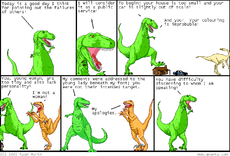- Tyrannosaurus in popular culture
-
Tyrannosaurus rex is arguably the most prevalent dinosaur to appear in popular culture.[1] It has been frequently represented in film and on television, in literature, and on the internet.
Contents
General impact
Tyrannosaurus rex is unique among dinosaurs in its place in modern culture; paleontologist Robert Bakker has called it "the most popular dinosaur among people of all ages, all cultures, and all nationalities".[1] From the beginning, it was embraced by the public. Henry Fairfield Osborn, the President of the American Museum of Natural History, billed it the greatest hunter to have ever walked the earth. He stated in 1905,[2]
“ I propose to make this animal the type of the new genus, Tyrannosaurus, in reference to its size, which far exceeds that of any carnivorous land animal hitherto described...This animal is in fact the ne plus ultra of the evolution of the large carnivorous dinosaurs: in brief it is entitled to the royal and high sounding group name which I have applied to it. ” Tyrannosaurus gained widespread public attention on December 30, 1905, when the New York Times hailed T. rex as "the most formidable fighting animal of which there is any record whatever," the "king of all kings in the domain of animal life," "the absolute warlord of the earth," and a "royal man-eater of the jungle." [3] In 1906, Tyrannosaurus was dubbed the "prize fighter of antiquity" and the "Last of the Great Reptiles and the King of Them All."[4]
In 1927, Charles R. Knight painted a mural incorporating Tyrannosaurus facing a Triceratops in the Field Museum of Natural History,[5] establishing the two dinosaurs as enemies in popular thought;[6] paleontologist Phil Currie cites this mural as one of his inspirations to study dinosaurs.[2] Bakker said of the imagined rivalry between Tyrannosaurus and Triceratops, "No matchup between predator and prey has ever been more dramatic. It’s somehow fitting that those two massive antagonists lived out their co-evolutionary belligerence through the very last days of the very last epoch of the Age of Dinosaurs."[6]
Film appearances
Tyrannosaurus rex has played a major role in many films, starting in 1918 with The Ghost of Slumber Mountain, written and directed by stop motion special effects pioneer Willis O'Brien.[7] The Ghost of Slumber Mountain is also, and most likely, the first film showing Tyrannosaurus facing Triceratops. The king of the tyrant lizards came back in 1925 with the classic adaptation of Arthur Conan Doyle's novel The Lost World. Tyrannosaurus fossils weren't so famous at the time of the publication of the novel (1912), and the only main villain dinosaur on the book was Allosaurus, with no appearance of Tyrannosaurus, but this 1925 film featured Tyrannosaurus anyway, for a more dramatic and spectacular effect.[8]
Stop motion animator Willis O'Brien, who had worked on The Ghost of Slumber Mountain and The Lost World, was again responsible of special effects in the 1933 monster movie King Kong, which featured a climactic battle between the giant ape and a Tyrannosaurus. The Tyrannosaurus model was made using a cast based on an early painting by Charles R. Knight. O'Brien stated that the battle between Kong and the Tyrannosaurus was one of the most technically difficult scenes in the film to animate. Many early films depicted Tyrannosaurus with an upright posture based on the current thinking of the time. Most of these films inaccurately portrayed the dinosaur with three prominent fingers on each hand like Allosaurus (though Tyrannosaurus had a third, vestigial finger, it wouldn't have been noticeable at first glance);[9] Walt Disney is reported to have informed dinosaur hunter Barnum Brown that "it looked better that way". Since that time, T. rex has appeared in a great number of "monster" films and educational documentaries.[2]
One of the most iconic depictions of Tyrannosaurus in film was in 1993's Jurassic Park, where dinosaurs including T. rex are brought back to life using blood from fossilized mosquitoes. In the film, the dinosaur breaks free of its theme park enclosure, and proceeds to roam the park while killing some of the visitors and staff it encounters. The popularity of T. rex has long had a reciprocal effect on dinosaur science; the popularity of Jurassic Park factored into the discovery of the dinosaur genus Scipionyx; fossils of this genus had laid in storage in a basement in Italy until the film's release attracted attention from the fossil owner.[10]
See also
References
- ^ a b Bakker, Robert (2000). "Prologue". In Fiffer S. Tyrannosaurus Sue. New York: W. H. Freeman & Company. pp. xi-xiv. ISBN 0-7167-4017-6.
- ^ a b c John "Jack" Horner and Don "Dino" Lessem, The Complete T. Rex (New York: Simon & Schuster, 1993), pages 58–62
- ^ “Mining for Mammoths in the Badlands: How Tyrannosaurus Rex Was Dug Out of His 8,000,000 Year old Tomb,” The New York Times, December 3rd, 1905, page SM1.
- ^ "The Prize Fighter of Antiquity Discovered and Restored," The New York Times December 30th, 1906, page 21.
- ^ “Charles Knight: Prehistoric Visions of a Beloved Muralist” 2002 Field Museum, In the Field article by Alexander Sherman
- ^ a b Bakker, R.T. 1986. The Dinosaur Heresies. New York: Kensington Publishing, p. 240. On that page, Bakker has his own T. rex/Triceratops fight.
- ^ T. rex: A Dinosaur in Hollywood (2005 documentary)
- ^ T. rex didn't actually featured in the book but O'Brien made sure there was a role for him in the film, T. rex: A Dinosaur in Hollywood (2005 documentary)
- '^ "T. rexs Missing 3rd Finger Found," Discovery News October 17, 2007.
- ^ Poling, Jeff (1998). Skippy the dinosaur. Journal of Dinosaur Paleontology. http://www.dinosauria.com/jdp/misc/scipionyx.html. Retrieved 2007-03-01.
Categories:- Animals in popular culture
- Tyrannosaurs
- Dinosaurs in fiction
Wikimedia Foundation. 2010.


